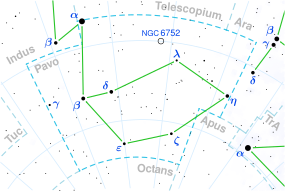SCR 1845−6357
Location of SCR 1845−6357 in the constellation Pavo | |
| Observation data Epoch J2000.0 Equinox J2000.0 (ICRS) | |
|---|---|
| Constellation | Pavo |
| Right ascension | 18h 45m 05.25325s[1] |
| Declination | −63° 57′ 47.4501″[1] |
| Apparent magnitude (V) | 17.4[2] |
| Characteristics | |
| SCR 1845−6357A | |
| Spectral type | M8.5[3] |
| SCR 1845−6357B | |
| Spectral type | T6[3] |
| Apparent magnitude (J) | 13.26[4] |
| Astrometry | |
| Proper motion (μ) | RA: 2583.190 mas/yr[1] Dec.: 588.504 mas/yr[1] |
| Parallax (π) | 249.6651 ± 0.1330 mas[1] |
| Distance | 13.064 ± 0.007 ly (4.005 ± 0.002 pc) |
| Details | |
| SCR 1845−6357A | |
| Mass | 0.0753±0.0088[5] M☉ |
| Radius | 0.0941±0.0039[5] R☉ |
| Luminosity | (2.649±0.026)×10−4[5] L☉ |
| Surface gravity (log g) | 5.0[5] cgs |
| Temperature | 2,400[5] K |
| SCR 1845−6357B | |
| Mass | 0.024 to 0.062[6] M☉ |
| Mass | 25 to 65[6] MJup |
| Radius | 0.7±0.1[6] RJup |
| Luminosity | 5.25+1.06 −0.88×10−6[6] L☉ |
| Surface gravity (log g) | 5.1[3] cgs |
| Temperature | 1,000±100[6] K |
| Age | ≥1.5[6] Gyr |
| Position (relative to A) | |
| Epoch of observation | J2006.3 |
| Angular distance | 1.064 ± 0.004″ [3] |
| Position angle | 177.2 ± 0.06° [3] |
| Projected separation | 4.10 ± 0.04 AU [7] |
| Other designations | |
| Database references | |
| SIMBAD | A |
| B | |
SCR 1845−6357 is a binary system, 13.1 light-years (4.0 parsecs) away in the constellation Pavo. The primary is a low-mass red dwarf, while the secondary is a brown dwarf. It is among the nearest stars, as well as the nearest red dwarf-brown dwarf binary.
System

The primary, SCR 1845−6357A, is an ultra-cool red dwarf, one of the smallest and coolest stars so far discovered, with a mass of about 7% of the Sun's, a radius 9.4% of the Sun's, and an effective temperature of 2,400 K (2,100 °C; 3,900 °F).[5] It is very faint, at an apparent magnitude of 17.4[2] due to its low luminosity, equivalent to 0.03% of the Sun's luminosity across all wavelengths.[6] It was discovered in 2004 by the SuperCOSMOS survey.[9]
This star has been found to have a brown dwarf companion in 2006, designated SCR 1845-6357 B.[10] The companion has an observed distance of 4.1 AU from the primary and is classified as a T-dwarf.[3] It is estimated to have between 25 to 65 times the mass of Jupiter (2.4 to 6.2% of the Sun's mass), but its radius is 30% smaller than that of Jupiter, about 50,000 km (31,000 miles). It has an effective temperature around 1,000 K (730 °C; 1,300 °F).[6]
Gallery
- Artist's impression of the SCR 1845-6357 stellar system
- SCR 1845–6357, right bottom
- Three-colour image of SCR1845−6357AB generated from the SDI filter images (blue=1.575 μm, green=1.600 μm, red=1.625 μm). Because the T-dwarf fades away towards the longer wavelengths, it appears quite blue in this image. It is roughly 50 times fainter than the star and is separated from it by an angle of 1.17″ on the sky (4.5 times the Earth-Sun distance).
See also
References
- ^ a b c d Vallenari, A.; et al. (Gaia collaboration) (2023). "Gaia Data Release 3. Summary of the content and survey properties". Astronomy and Astrophysics. 674: A1. arXiv:2208.00211. Bibcode:2023A&A...674A...1G. doi:10.1051/0004-6361/202243940. S2CID 244398875. Gaia DR3 record for this source at VizieR.
- ^ a b c "SCR J1845-6357". SIMBAD. Centre de données astronomiques de Strasbourg. Retrieved 5 November 2023.
- ^ a b c d e f g Kasper, Markus; Biller, Beth A.; Burrows, Adam; Brandner, Wolfgang; Budaj, Jano; Close, Laird M. (August 2007). "The very nearby M/T dwarf binary SCR 1845-6357". Astronomy and Astrophysics. 471 (2): 655–659. arXiv:0706.3824. Bibcode:2007A&A...471..655K. doi:10.1051/0004-6361:20077881.
- ^ Chris Gelino; Davy Kirkpatrick; Adam Burgasser. "DwarfArchives.org: Photometry, spectroscopy, and astrometry of M, L, and T dwarfs". caltech.edu. Archived from the original on 2013-11-13. Retrieved 2012-06-10. (main page) Archived 2019-05-11 at the Wayback Machine
- ^ a b c d e f Cifuentes, C.; Caballero, J. A.; Cortés-Contreras, M.; Montes, D.; Abellán, F. J.; Dorda, R.; Holgado, G.; Zapatero Osorio, M. R.; Morales, J. C.; Amado, P. J.; Passegger, V. M.; Quirrenbach, A.; Reiners, A.; Ribas, I.; Sanz-Forcada, J. (2020-10-01). "CARMENES input catalogue of M dwarfs. V. Luminosities, colours, and spectral energy distributions". Astronomy and Astrophysics. 642: A115. arXiv:2007.15077. Bibcode:2020A&A...642A.115C. doi:10.1051/0004-6361/202038295. ISSN 0004-6361. SCR 1845-6357 A's database entry at VizieR.
- ^ a b c d e f g h Vigan, A.; Bonnefoy, M.; Chauvin, G.; Moutou, C.; Montagnier, G. (2012-04-01). "High-contrast spectroscopy of SCR J1845-6357 B". Astronomy & Astrophysics. 540: A131. arXiv:1204.0241. doi:10.1051/0004-6361/201118426. ISSN 0004-6361.
- ^ Observed projected distance computed from parallax and observed angular distance.
- ^ Golovin, Alex; Reffert, Sabine; Just, Andreas; Jordan, Stefan; Vani, Akash; Jahreiß, Hartmut (November 2022). "The Fifth Catalogue of Nearby Stars (CNS5)". Astronomy & Astrophysics. 670: A19. arXiv:2211.01449. Bibcode:2023A&A...670A..19G. doi:10.1051/0004-6361/202244250. S2CID 253264922. Catalogue can be accessed here.
- ^ Hambly, Nigel C.; Henry, Todd J.; Subasavage, John P.; Brown, Misty A.; Jao, Wei-Chun (2004). "The Solar Neighborhood. VIII. Discovery of New High Proper Motion Nearby Stars Using the SuperCOSMOS Sky Survey". The Astronomical Journal. 128 (1): 437–447. arXiv:astro-ph/0404265. Bibcode:2004AJ....128..437H. doi:10.1086/421748. S2CID 9586813.
- ^ Biller, B. A.; Kasper, M.; et al. (April 2006). "Discovery of a Brown Dwarf Very Close to the Sun: A Methane-rich Brown Dwarf Companion to the Low-Mass Star SCR 1845-6357". The Astrophysical Journal. 641 (2): L141 – L144. arXiv:astro-ph/0601440. Bibcode:2006ApJ...641L.141B. doi:10.1086/504256.
External links
- New Objects within 20 light-years at SolStation.
- SCR 1845−6357




